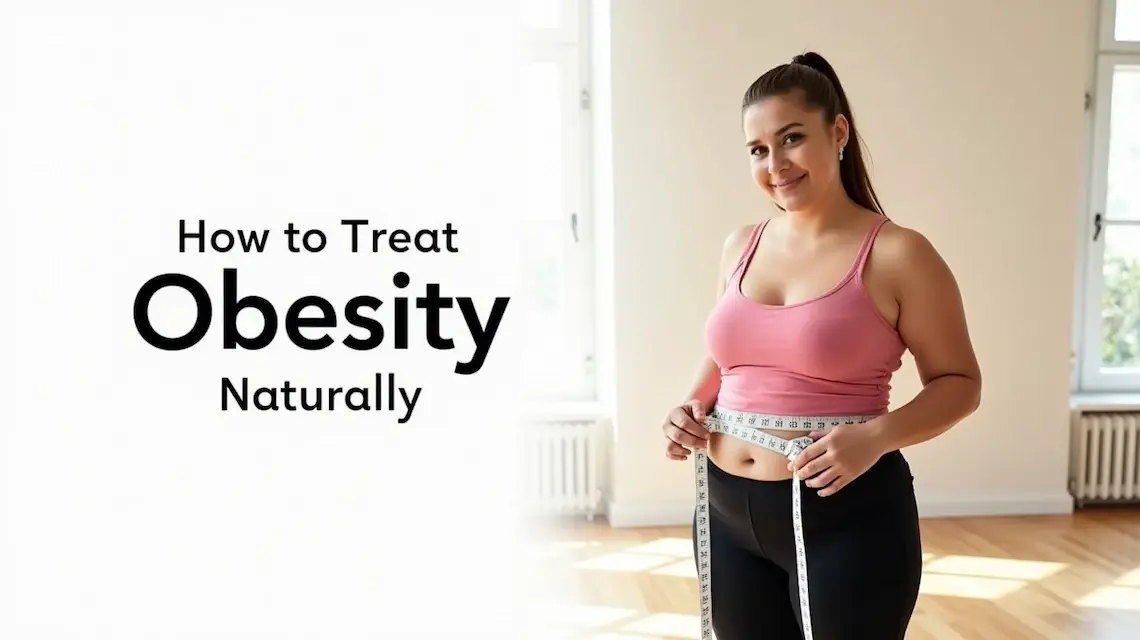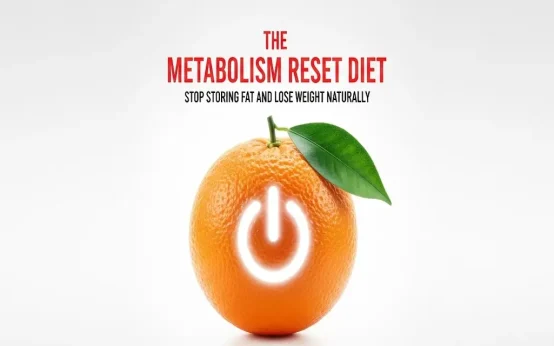Obesity is rising fast, and so are risks like type 2 diabetes and heart disease. If you’re asking how to treat obesity naturally, you’re in the right place. Natural care works with your body, not against it, and can fit your life without drugs or surgery.
Put simply, obesity means carrying too much body fat for your height, which strains your heart, hormones, joints, and mood. The appeal of natural treatments is clear, you build skills you can keep for life. You also reduce side effects, improve energy, and protect long-term health.
This guide focuses on practical, evidence-based steps you can start today. You’ll learn how to shape meals that support steady fat loss, how to move in ways that burn calories and protect muscle, and how to sleep so your hunger hormones stay balanced. You’ll also see how stress, hydration, and daily habits can speed results.
Always talk with your doctor before making big changes, especially if you have medical conditions or take medication. They can help you set safe targets and track progress. Small, steady changes beat crash plans every time.
Here’s what’s ahead, clear and simple, how to treat obesity naturally with a proven plan for diet, exercise, and sleep, plus habit tweaks that make progress stick. We’ll keep it realistic, science-informed, and friendly to your schedule. Ready to build a plan you can live with?
Understanding the Root Causes of Obesity
Obesity rarely has a single cause. It builds from daily choices, biology, and environment. Public health groups like the WHO and CDC point to diet, inactivity, stress, sleep, and genetics as key drivers. If you want to know how to treat obesity naturally, start by understanding which drivers hit you hardest. When you see the pattern, you can change it.
Genetics set a baseline for appetite, fat storage, and metabolism. They do not lock in your fate. Daily habits still shape weight over time.
How Diet and Lifestyle Habits Lead to Weight Gain
Many people gain weight from small, repeat choices that add up. Some are easy to miss until you track them.
Common culprits:
- Processed foods with refined carbs and low fiber that spike hunger fast.
- Sugary drinks that add calories without fullness.
- Oversized portions at restaurants and at home.
- Mindless snacking while scrolling or watching TV.
- Skipping meals, then overeating at night.
- Alcohol that lowers restraint and raises calorie intake.
- Sedentary time that reduces daily burn.
Simple ways to spot your triggers:
- Keep a 3-day food and mood log. Note hunger, stress, and time.
- Use a hunger scale from 1 to 10 before and after meals.
- Snap photos of portions. Compare plate size to your palm.
- Track steps for a week. See how weekends differ from weekdays.
- Audit your environment. Put treats out of sight, fruit at eye level.
- Identify social cues. Work snacks, late dinners, or takeout nights.
Small fixes work best. Swap sugary drinks for water or tea. Build meals around protein, vegetables, and high fiber carbs. Set a 10-minute walk after meals. Add standing or stretch breaks each hour.
The Role of Stress and Sleep in Obesity
Chronic stress raises cortisol, which pushes appetite, cravings, and belly fat. Poor sleep creates sleep debt that disrupts hormones. Ghrelin goes up, leptin goes down, and you feel hungrier. Your body also handles blood sugar less well when tired, so you store more.
Quick, natural supports:
- Keep a consistent sleep window, even on weekends.
- Get morning sunlight and dim lights one hour before bed.
- Cut caffeine after noon and limit alcohol at night.
- Create a wind-down cue, like a warm shower or light reading.
- Use 4-7-8 breathing, a short walk, or a 5-minute stretch to lower stress.
- Plan worries on paper earlier in the evening, not in bed.
- Lift or do brisk walks to buffer stress and improve sleep quality.
- Build support. Share goals with a friend and set phone limits at night.
Addressing stress and sleep makes weight loss feel easier. You curb cravings, improve energy, and create a foundation for steady progress.
Natural Diet Changes to Treat Obesity Effectively
Food choices set the pace for safe, steady fat loss. Focus on whole foods, portion control, and simple habits you can keep. A Mediterranean-style pattern, rich in vegetables, fruits, whole grains, beans, fish, and olive oil, is backed by studies for weight and heart health. This is a practical way to approach how to treat obesity naturally without strict rules or fad diets.
Drink more water across the day. Aim for a glass before meals, herbal tea in the afternoon, and seltzer with citrus in the evening. Hydration supports appetite control and steady energy.
Building a Balanced Plate for Weight Loss
Use an easy plate guide. Fill half your plate with non-starchy vegetables, one quarter with lean protein, and one quarter with whole grains or starchy vegetables. Add a small portion of healthy fat for flavor and fullness.
Great options:
- Half plate veggies: leafy greens, broccoli, peppers, tomatoes, zucchini, carrots.
- Quarter protein: chicken breast, fish, turkey, tofu, beans, eggs, Greek yogurt.
- Quarter grains or starch: quinoa, brown rice, farro, potatoes, corn, whole-grain pasta.
- Healthy fats: olive oil, avocado, nuts, seeds.
Meal ideas:
- Big salad with mixed greens, chickpeas, grilled salmon, olive oil, lemon.
- Grilled chicken, roasted broccoli, and quinoa with a spoon of pesto.
- Veggie omelet, side of berries, and one slice of whole-grain toast.
Keep portions in check. Use the palm of your hand for protein, a cupped hand for grains, and two fists for vegetables. This plate keeps calories reasonable while protein and fiber protect fullness.
Smart Swaps to Cut Calories Without Feeling Hungry
Small swaps trim calories without leaving you craving more. Go for foods with high fiber and water, and enough protein to keep you satisfied.
Try these:
- Swap soda for water, seltzer, or unsweetened tea. Flavor with lime or mint.
- Swap fries for baked veggies, like carrot fries, squash wedges, or roasted potatoes.
- Swap white bread for whole-grain bread. More fiber, better blood sugar control.
- Swap creamy sauces for salsa, tomato sauce, or Greek yogurt dressings.
- Swap candy for fruit with a few nuts or a piece of dark chocolate.
Why this works long term:
- Lower calorie density helps you eat more volume for fewer calories.
- More fiber and protein reduces hunger and late-night snacking.
- Stable blood sugar makes energy and mood steadier, so habits stick.
The Power of Intermittent Fasting Basics
Intermittent fasting can help some people eat less without counting every calorie. The 16/8 method is a simple start. You fast for 16 hours, then eat within an 8-hour window, such as 10 a.m. to 6 p.m. Focus on balanced meals, not grazing, during the eating window.
Potential benefits for obesity:
- Built-in meal timing reduces mindless snacking.
- May improve insulin sensitivity and appetite rhythms.
- Simple structure makes choices easier.
Keep these precautions in mind:
- Not for pregnancy, eating disorders, or if you are under 18.
- If you have diabetes or take medications, talk to your doctor first.
- Do not binge when the window opens. Stick to whole foods and your balanced plate.
- Stay hydrated. Water, black coffee, and unsweetened tea during the fast are fine.
- Start gently. Try 12/12 for a week, then move to 14/10 or 16/8 if you feel good.
Combine fasting with the Mediterranean-style plate and smart swaps. You will treat obesity naturally by eating real food, honoring hunger cues, and keeping habits you can repeat.
Exercise and Movement Routines for Natural Weight Management
Movement is the engine behind steady fat loss. It improves insulin sensitivity, builds muscle, and lifts mood. The American College of Sports Medicine suggests at least 150 minutes of moderate cardio weekly, plus 2 to 3 days of strength work. Start simple, stay consistent, and you will see how to treat obesity naturally with habits you can keep.
Starting with Low-Impact Cardio to Boost Metabolism
Begin with 30-minute walks most days. Aim for a brisk pace that raises your heart rate but still lets you talk. This supports heart health, burns calories, and eases stress. If joints feel tight, try swimming or cycling for a similar calorie burn without pounding.
Simple weekly plan:
- 5 days of 30-minute walks, or 3 days of 20 to 30 minutes of swimming.
- Add 5 to 10 minutes of easy warm-up and cool-down.
- Use intervals to progress, 2 minutes brisk, 1 minute easy, repeat.
Why it works:
- Steady calorie burn without harsh wear and tear.
- Improved circulation and heart function.
- Better insulin response, which helps reduce belly fat.
Track results with a step counter or time goals. Shoot for 6,000 to 8,000 daily steps at first, then build toward 8,000 to 10,000.
Incorporating Strength Training to Build Lean Muscle
Muscle is your built-in calorie burner. Train 2 to 3 times per week, nonconsecutive days. Use bodyweight at home or machines and free weights at the gym.
Try this 20 to 30 minute circuit, 2 to 3 rounds:
- Squats or chair sit-to-stands, 10 to 15 reps.
- Push-ups or incline push-ups, 8 to 12 reps.
- Hip bridges, 12 to 15 reps.
- Rows, resistance band or machine, 10 to 12 reps.
- Plank, 20 to 40 seconds.
Progress by adding a rep or a small weight each week. Log sets, reps, and how it felt. Expect better posture, tighter core, and higher daily burn.
Fun Activities to Stay Active Long-Term
Enjoyment keeps you moving. Pick activities that feel like play, not work.
- Dancing in your living room, 20 to 30 minutes.
- Hiking on weekends with a friend.
- Pickleball or casual sports for built-in intervals.
- Yoga 1 to 2 times weekly for mobility and stress relief.
Blend cardio, strength, and yoga. You will improve consistency, recover faster, and make movement a habit that supports weight loss for life.
Lifestyle Habits and Natural Remedies to Support Obesity Treatment
Habits set the stage for steady progress. When you sleep well, manage stress, and use simple natural aids wisely, it gets easier to eat better and move more. These tools round out how to treat obesity naturally, and they work best alongside your diet and exercise plan.
Improving Sleep and Reducing Stress Naturally
Sleep and stress control hunger and energy. Short sleep raises ghrelin, lowers leptin, and drives cravings. Stress pushes cortisol up, which can boost belly fat and snack urges. Set a calm rhythm that protects both.
Try a simple nightly routine:
- Keep a consistent bedtime and wake time, even on weekends.
- Get 10 to 15 minutes of morning light to anchor your body clock.
- Cut caffeine after noon. Limit alcohol at night.
- Dim lights one hour before bed. Read, stretch, or take a warm shower.
- Use a mindfulness app for 5 to 10 minutes. Breathing, body scans, or short meditations all help.
Lower daytime stress with short resets:
- Walk for 10 minutes after meals.
- Use box breathing, 4-4-4-4, for two minutes.
- Schedule worries on paper, not in bed.
Track what works. Use a sleep diary, wearable, or a simple checklist. Note bedtime, wake time, naps, and screens. Share goals with a friend, join a group chat, or check in with a coach. Social support keeps habits steady and pays off on the scale.
Herbal Teas and Supplements That May Help
Some natural aids can support appetite control and calorie burn. They are not cures. Use them as small helpers.
- Green tea: Catechins plus caffeine may raise calorie burn slightly and support fat loss in studies. Many people sip 2 to 3 cups daily. If using extracts, watch for caffeine and EGCG amounts. Stop if you feel jittery or unwell.
- Ginger: May help reduce appetite and improve digestion in small trials. Grated fresh ginger in hot water or 1 to 2 grams daily in capsules is common.
- Fiber supplements: Psyllium or glucomannan before meals can boost fullness and help blood sugar control. Start low, 3 to 5 grams, and drink plenty of water.
Important cautions:
- Check with your doctor or pharmacist first, especially if you take blood thinners, diabetes meds, or have liver issues.
- Start one change at a time so you can track effects.
- Pair any supplement with a whole-food diet, movement, sleep, and stress care. That is how to treat obesity naturally with a clear, holistic plan.
Conclusion
Natural care works when it fits everyday life. The core moves are simple. Eat mostly whole foods with plenty of protein, fiber, and plants. Walk or cycle most days, and lift 2 to 3 times each week. Guard sleep, ease stress, and drink more water. Add small supports like green tea, ginger, or fiber if they make sense for you.
This is how to treat obesity naturally with habits you can keep. Track what you do, not just what you weigh. Plan meals, set movement on your calendar, and build social support. Stay patient, since steady loss protects muscle and mood. Speak with your healthcare provider, especially if you take medication or have health conditions. Safety and a clear plan speed progress.
Start tiny today. Pick one habit you can do in 5 minutes, like a brisk walk after lunch or a protein-first breakfast. Repeat it tomorrow, then add the next step when ready. Your future health depends on what you practice, not on perfection. Ready to make that first move right now?
Related post: What is the Best Exercise for Obese People
FAQ:
What does “treating obesity naturally” mean?
It means using lifestyle changes, not drugs or surgery. Core tools include nutrition, movement, sleep, stress care, and behavior habits. These methods can stand alone or support medical care if needed.
How much weight loss is realistic with natural methods?
A 5 to 10 percent loss in 3 to 6 months is common with steady habits. That amount improves blood pressure, blood sugar, and lipids. Aim for a small daily calorie deficit, about 300 to 500 calories.
Which diet works best for natural weight loss?
The best diet is one you can stick with. Whole foods, fewer ultra-processed foods, enough protein, and high fiber work across many styles, like Mediterranean, low carb, or low fat.
How much protein and fiber should I eat?
Protein supports fullness and muscle. Aim for 1.2 to 1.6 grams per kilogram of body weight each day, higher if you lift weights. Fiber slows digestion and curbs hunger. Target 25 to 38 grams per day from plants.
Do I need to count calories?
You can, but it is not required. Many people do well using portion guides, plate methods, or tracking protein and fiber. If weight stalls, a short period of logging can help spot gaps.
Are carbs bad for obesity?
No. Refined carbs and sugary drinks drive hunger and high calories. Whole carbs, like oats, beans, fruit, and sweet potatoes, support fullness and health. Choose fiber-rich sources most of the time.
What about intermittent fasting?
It can help some people eat fewer calories. Simple windows, like 10 to 12 hours of daytime eating, may be easier to keep. Do not skip meals if it leads to binge eating or low energy.
How much exercise do I need?
Aim for 150 to 300 minutes of moderate cardio each week, plus 2 to 3 days of strength training. Build daily movement too, like walking, taking stairs, and standing breaks. Strength work helps protect muscle while you lose fat.
Can I lose weight without exercise?
Yes, through diet, but it is harder to keep off. Exercise helps maintain muscle and increases daily calorie burn. Even light movement improves results and health markers.
How does sleep affect weight?
Short sleep raises hunger hormones and cravings. Get 7 to 9 hours a night. Keep a regular schedule, cool room, dark space, and a screen-free wind down.
What role does stress play?
Chronic stress can raise appetite and drive comfort eating. Use brief stress tools daily, like walks, breathing drills, short naps, or journaling. Even 5 minutes helps.
Which habits curb hunger naturally?
- Eat 20 to 30 grams of protein per meal
- Include bulky vegetables and beans
- Drink water before meals
- Eat slowly, about 15 to 20 minutes per meal
- Do not drink your calories, skip sugary drinks and limit alcohol
Are supplements helpful?
Most weight loss supplements do little, and some carry risks. Caffeine or green tea have small effects at best. Avoid products with hidden stimulants. Talk to your clinician before using any supplement, especially if you take meds.
Is apple cider vinegar useful?
It may slightly lower post-meal blood sugar for some people. It does not produce large weight loss. If you use it, dilute it, protect your teeth, and avoid if you have stomach issues or take certain meds.
Why did my weight loss stall?
Your body adapts. As you lose weight, you burn fewer calories. Tighten portions, add 2,000 to 3,000 extra steps per day, raise protein, and review weekend eating. Small changes restart progress.
How important is hydration?
Very. Thirst often feels like hunger. Aim for pale yellow urine. Water, unsweetened tea, and black coffee count. Limit alcohol, it adds calories and lowers food restraint.
Can natural methods help with PCOS or insulin resistance?
Yes, with tailored focus. Emphasize protein, fiber, and strength training. Cut sugary drinks and refined carbs. Some do better with lower carb plans. Work with your clinician for labs and added support.
What about menopause-related weight gain?
Hormone shifts affect body fat and muscle. Strength training, enough protein, and consistent sleep become even more important. Watch alcohol and evening snacks. Progress may be slower, but still possible.
Do I need blood tests before I start?
It helps. Ask about A1C or fasting glucose, lipids, thyroid function, liver enzymes, and vitamin D. These guide your plan and flag issues that need medical care.
Is natural treatment safe for everyone?
Most people benefit from lifestyle changes. If you are pregnant, nursing, underweight, or have an eating disorder, seek medical advice first. If you take meds for diabetes or blood pressure, tell your clinician before major diet changes.
How do I stick with it long term?
Make it easy and specific. Plan simple meals, keep trigger foods out of reach, pair habits with cues, like a walk after coffee, and track two numbers, like steps and protein. Expect lapses, then restart at the next meal.
What goals should I set?
Use process goals you control. Examples, 8,000 to 10,000 steps per day, 25 grams of fiber daily, three strength sessions per week, and two liters of water daily. Pair with a weight trend over weeks, not days.
When should I consider medical treatment?
If lifestyle changes do not produce at least 5 percent loss after 3 to 6 months, or if you have obesity-related conditions, talk to your clinician. Natural methods still help, even if you add medication or other care.
Can I lose weight while eating out or traveling?
Yes, with simple rules. Look for grilled or baked options, ask for sauces on the side, start with a salad or broth soup, share large portions, and keep alcohol modest. Walk daily to offset long sitting.
What does a simple day of meals look like?
- Breakfast, Greek yogurt, berries, and oats
- Lunch, bean and chicken salad with olive oil and vinegar
- Snack, apple and a handful of nuts
- Dinner, salmon, roasted vegetables, and quinoa
- Drinks, water, tea, or black coffee
How fast should I expect results?
Aim for 0.5 to 1 pound per week. Faster loss can happen at first from water shifts. Slow and steady tends to stick.
Any red flags to watch for?
Skip extreme diets, miracle pills, and detoxes. Watch for dizziness, fainting, hair loss, or missed periods. If these show up, get medical advice and adjust your plan.




 How to Start a Weight Loss Program
How to Start a Weight Loss Program  What Vitamin Deficiency Makes It Hard to Lose Weight?
What Vitamin Deficiency Makes It Hard to Lose Weight?  Improve Fat Burning With a Metabolism Reset Diet
Improve Fat Burning With a Metabolism Reset Diet  How to Avoid Loose Skin When Losing Weight
How to Avoid Loose Skin When Losing Weight  Good Eating Habits for Weight Loss
Good Eating Habits for Weight Loss  A Guide to Weight Loss for Busy People in Today’s Society
A Guide to Weight Loss for Busy People in Today’s Society